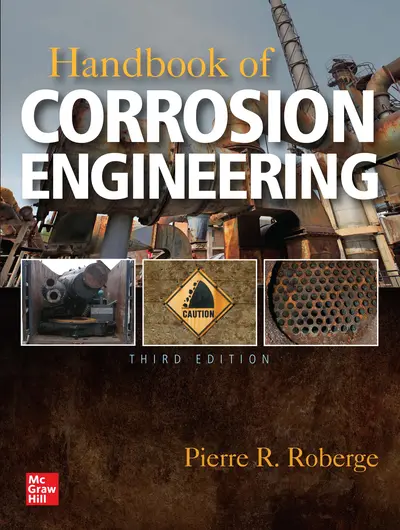My Account Details

ISBN10: 1260116972 | ISBN13: 9781260116977

Step 1 . Download Adobe Digital Editions to your PC or Mac desktop/laptop.
Step 2. Register and authorize your Adobe ID (optional). To access your eBook on multiple devices, first create an Adobe ID at account.adobe.com. Then, open Adobe Digital Editions, go to the Help menu, and select "Authorize Computer" to link your Adobe ID.
Step 3. Open Your eBook. Use Adobe Digital Editions to open the file. If the eBook doesn’t open, contact customer service for assistance.
Publisher's Note: Products purchased from Third Party sellers are not guaranteed by the publisher for quality, authenticity, or access to any online entitlements included with the product.
The most complete corrosion control reference on the market―thoroughly revised for the latest advances
This fully updated guide offers complete coverage of the latest corrosion-resistant materials, methods, and technologies. Written by a recognized expert on the subject, the book covers all aspects of corrosion damage, including detection, monitoring, prevention, and control. You will learn how to select materials and resolve design issues where corrosion is a factor. Handbook of Corrosion Engineering, Third Edition shows, step by step, how to understand, predict, evaluate, mitigate, and correct corrosion problems. This edition provides a new focus on the management of corrosion problems and draws on methodologies and examples from the 2016 IMPACT report. A new chapter discusses corrosion management across governments and industries.
Coverage includes:
• The functions and roles of a corrosion engineer
• Atmospheric corrosion and mapping atmospheric corrosivity
• Corrosion in waste water treatment and in water and soils
• Corrosion of reinforced concrete
• Microbes and biofouling
• High-temperature corrosion
• Modeling corrosion processes and life prediction
• Corrosion failures
• Corrosion maintenance through inspection and monitoring
• Corrosion management across governments and industries
• Selection and design considerations for engineering materials
• Protective coatings and corrosion inhibitors
• Cathodic and anodic protection
Acknowledgments
About the Author
Chapter 1. Introduction
1.1 The Concept of Corrosion in History
1.2 Visualizing Corrosion Cells
1.3 A Simple Corrosion Model
1.4 Corrosion in Our Daily Life
1.5 Strategic Impact and Cost of Corrosion Damage
1.6 What Corrosion Engineers Do?
References
Chapter 2. Atmospheric Corrosion
2.1 Introduction
2.2 Outdoor Atmospheres
2.3 Indoor Atmospheres
2.4 Atmospheric Corrosivity Factors and Their Measurement
2.5 Atmospheric Corrosion Tests
2.6 Prevention and Control
References
Chapter 3. Corrosion in Water and Seawater
3.1 Introduction
3.2 Corrosion and Water Quality/Availability
3.3 Types of Water
3.4 Cooling Water Systems
3.5 Steam Generating Systems
3.6 Water Treatment
3.7 Scaling Indices
3.8 Lead Corrosion: Chloride-to-Sulfate Mass Ratio
3.9 Corrosion in Seawater
References
Chapter 4. Corrosion in Soils
4.1 Introduction
4.2 Soil Classification
4.3 Soil Parameters Affecting Corrosivity
4.4 Soil Corrosivity Classifications
4.5 Soil Corrosion Cells
4.6 Auxiliary Effects of Corrosion Cells
4.7 Examples of Buried Systems
4.8 Corrosion of Materials Other Than Steel
References
Chapter 5. Corrosion of Reinforced Concrete
5.1 Introduction
5.2 Degradation of Reinforced Concrete
5.3 Remedial Measures
5.4 Condition Assessment of Reinforced Concrete Structures
5.5 Other Forms of Concrete Degradation
References
Chapter 6. Microorganisms and Biofouling
6.1 Introduction
6.2 Examples of Microbial Corrosion
6.3 Nature of Biofilms
6.4 Biofilm Formation and Growth
6.5 Marine Biofouling
6.6 Problems Associated with Biofilms
6.7 Biocorrosion Mechanisms
6.8 Microorganisms Classification
6.9 Monitoring Microbiologically Influenced Corrosion
6.10 Biofilm Control
References
Chapter 7. Modeling and Life Prediction
7.1 Models, Computers, and Corrosion
7.2 Early Models (Historical Notes)
7.3 Bottom-Up Corrosion Models
7.4 Top-Down Corrosion Models
7.5 Corrosion Information and Communication Technologies
References
Chapter 8. Corrosion Failures
8.1 Introduction
8.2 Mechanisms and Forms of Corrosion Failures
8.3 Investigating Corrosion Failures
References
Chapter 9. Corrosion Management, Maintenance, and Inspection
9.1 The Cost of Poor Maintenance
9.2 Corrosion Management Strategies
9.3 The Impact Corrosion Management System
9.4 Maintenance Strategies
9.5 Inspection Strategies
9.6 Industrial Examples
References
Chapter 10. Corrosion Monitoring
10.1 What Is Corrosion Monitoring?
10.2 Corrosion Monitoring Techniques
10.3 Corrosion Monitoring Locations
10.4 Corrosion Monitoring Systems
10.5 Integration in Process Control
10.6 Modeling the Corrosion Monitoring Response
10.7 Probe Design and Selection
10.8 Data Communication and Analysis Requirements
References
Chapter 11. Engineering Materials: Selection and Design Considerations
11.1 Materials Selection
11.2 Corrosion Aware Materials Selection
11.3 Selection Compromises
11.4 Materials Selection Road Map
11.5 Basics of Metallurgy
11.6 Engineering Materials
11.7 Design Considerations
References
Chapter 12. Protective Coatings
12.1 Types of Coatings
12.2 Why Coatings Fail
12.3 Soluble Salts and Coating Failures
12.4 Economic Aspects of Coatings Selection and Maintenance
12.5 Organic Coatings
12.6 Inorganic (Nonmetallic) Coatings
12.7 Metallic Coatings
12.8 Coating Inspection and Testing
12.9 Surface Preparation
References
Chapter 13
Need support? We're here to help - Get real-world support and resources every step of the way.